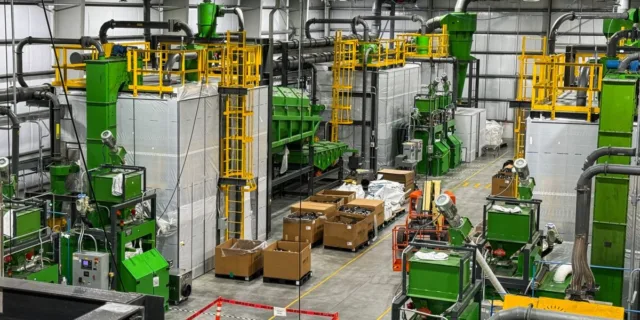Tesla cofounder JB Straubel served as the brains behind the battery development for the electric vehicle giant, and he saw firsthand the massive amounts of critical minerals that are potentially wasted when it comes time to retire each EV—raw materials ripe for recycling and redeploying.
China dominates most of the world’s critical mineral supply chains. Each EV battery represents a treasure trove of lithium, cobalt, copper, nickel, and more that can be reused for brand-new batteries for energy storage and all sorts of devices from AI data centers to military equipment to smartphones and computers. There are 60 natural elements deemed “critical minerals” by the U.S. government, and America only produces a small minority of them.
Straubel founded Redwood Materials in 2017, which is rapidly expanding and has grown into the United States’ first line of defense for recycling critical minerals in the potential supply-chain cold war with China—now at a temporary truce.
“Being able to tap into materials that are already in the market can dramatically reduce the pressure on what’s needed to mine,” Straubel told Fortune. “Once you have some diversity of supply, you reduce the risk of the [Chinese] monopoly and the geopolitical concentration.”
Since the U.S. launched a tariff war earlier this year and China threatened to withhold certain critical minerals, the U.S. has aggressively emphasized investments and partnerships for developing its own critical minerals mining, refining, recycling, and magnet and battery manufacturing. China currently accounts for over 80% of the global production of battery materials.

Developing domestic
The U.S. can’t just open a dozen new mines overnight. Recycling will increasingly play a key role, and Redwood Materials already controls roughly 90% of lithium-ion battery recycling in North America—the equivalent of 250,000 EV batteries per year. Still, that 90% equals only about 10% of the EV battery deployment in the U.S. each year. That means Redwood could expand its capacity by 10 times even if the EV market share stays flat in the U.S.
Straubel refers to Redwood’s facilities as “urban mines.” Redwood leads its battery recycling from its Nevada campus and now has a brand-new, $3.5 billion, 600-acre plant in South Carolina. Nvidia recently came on as a strategic investor.
“The end goal is creating a circular economy where recycling—not mining—becomes the primary source of the minerals,” Straubel said. “You’re decoupled from the geologic mine from where these things are naturally found in the earth.”
Already, Redwood is the nation’s unofficial leading “miner” of cobalt through its recycling efforts, and near the top in lithium and nickel.
“It’s kind of obvious, but not very intuitive, that almost all of the raw materials inside of batteries are reusable,” Straubel said. “They don’t get consumed in the application. We build the device, spend a lot of effort doing it, but then it basically just stays there its whole life.
“As EVs and other energy storage products proliferate in the market, we have this incredible opportunity to evolve toward this materials economy for those products that will be 98% or 99% remanufactured over time.”
As well as mining batteries for parts, Redwood already is developing its own battery energy storage systems, called BESS, from recycled materials, especially as batteries are increasingly partnered with solar and wind power for increased reliability. Redwood already deployed a battery storage microgrid for OpenAI’s Stargate data center campus in Texas.
Redwood’s main source of batteries is EVs, but the company can recycle lithium-ion batteries in all shapes and sizes. Getting access to them is the challenge.
“For EVs, it’s relatively easier because of the size and scale. You can’t just put it in your garbage can. That’s more of a business-to-business pathway. It’s much harder with the consumer products and devices. That tends to unfortunately have a high percentage that end up in dumps and landfills. It can be dangerous too,” Straubel said, noting that most landfill fires are caused by misplaced battery incidents.
The U.S. must do a better of informing consumers about proper battery disposal and making disposal locations much more accessible, he said. “In the U.S., there aren’t strong programs or rules on this yet.”
Magnet remanufacturing
Apart from batteries, the other products dominated by China are high-performance magnets used in all kinds of electronics, including vehicles, drones, and missiles.
These specialized magnets depend on rare earths that make up 17 of the 60 designated critical minerals.
The only leading U.S. rare earths miner is MP Materials and its Mountain Pass mine in California. Now, MP Materials is focused on building out its magnet production and recycling capabilities.
The U.S. Department of Defense even bought a 15% ownership stake in MP, and then the company inked a $500 million partnership with Apple to produce rare earths magnets from 100% recycled materials.
“When you make a magnet, typically 20% to 50% of the material in the manufacturing and finishing process falls off the line in the form of waste. That’s a huge piece of your cost structure,” MP Materials CEO James Litinsky told Fortune. “If you have a refinery and the capability to bring that back into your business and recycle it, that’s a huge economic advantage.”
That is the last part of what Litinsky calls the domestic vertical integration strategy—mining, refining, magnet production, and recycling.
“Multibillion-dollar supply chains don’t move overnight, and it was very clear that this would take a long time. We’ve done it thoughtfully in stages,” Litinsky said. “You’re going to see us grow our recycling business because it’s critical to being an efficient magnetics business.”









